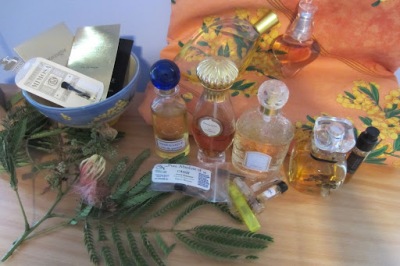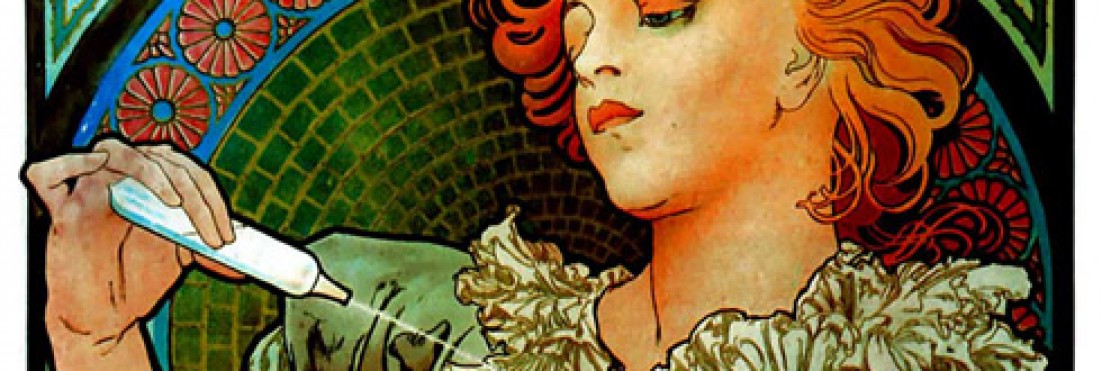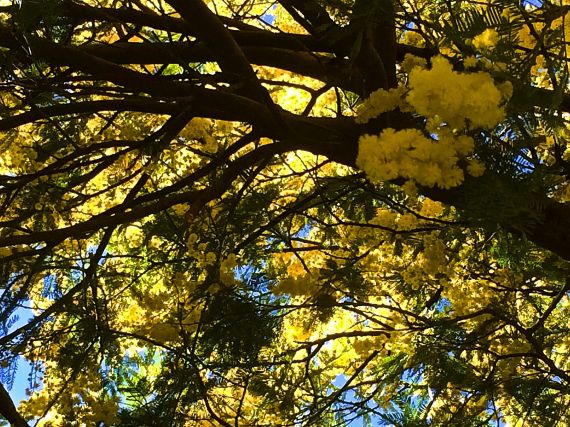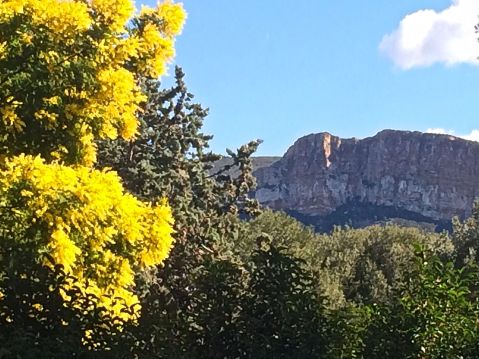Chatting with a good friend on our usual after-coffee stroll, I become distracted by a permeating, dry, vegetal, polleny, almost bleachy odor that I have not smelled for years. A fragrance which has haunted me since I first discovered it, long ago, in Aix-en-Provence. A fragrance which has more that once driven me to spend my last moments abroad stuffing zip-lock bags with dried blossoms to assure an olfactory fix for months on end once I’m back in the States. After nearly a decade of depravation, suddenly I’m enveloped in this strangely seductive odor.
I interrupt my friend: “That smell. Where is it coming from?” She points in the direction of my left shoulder. I turn to find that I’m standing directly under a mimosa tree in glorious, garish, golden bloom. I inhale.
If you live in a climate where it grows (California, southern France, parts of Italy, for example) mimosa may be familiar, even common. Common as in ubiquitous. Common as is in not particularly fine or sought-after. The stuff of country kitsch motifs on souvenir trinkets and table linens. For me, though, it is the Holy Grail of fragrance.
I have learned from perfumers in France and Italy that the there are over 1000 varieties of mimosa. The one on which I’ve imprinted may be acacia dealbata or acacia farnesiana–not to be confused with acacia– also called cassie —not to be confused with cassis or cassia, or even the city of Cassis (more about that here).
Since mimosa will not grow in the humid climate I now call home, I’ve been on a decades-long mission to find a facsimile of the scent that makes me swoon. And having tested every mimosa soliflore and blend that has crossed my nose, thanks to patient sales assistants, workshop facilitators, perfumers, and countless perfumista sample-sharers (you know who you are, and I thank you once again!), I can say with confidence that none of them smells like the flower, though they all smell more like mimosa than, say, rose, gardenia, lily of the valley, magnolia, honeysuckle, jasmine, tuberose, violet, violet leaf–well, you get the idea.
I find mimosa extracts, oils, and perfumes somewhat sweet or almondy or powdery–three adjectives I would not apply to the natural flower. Is it possible that mimosa, like coumarin, is perceived differently by different noses? I remember filling an apartment with bouquets of fragrant mimosa that two of my housemates could scarcely detect, while the third had to open a window to dissipate their insistent sillage.
In one of my countless attempts to find mimosa in a bottle, I spoke with a perfume shop owner in Florence who understood my plight. He explained that due to their dryness, mimosa flowers are hard pressed to be pressed as it were, or to submit to various means of odor extraction. Aha! So it wasn’t just my nose. But other perfumers have insisted this is not true. Further detective work proved validating, which is to say, disappointing. Says Roja Dove: “[…] it is almost impossible to find an oil that naturally smells of mimosa as, with so many materials, the oil smells nothing like the primary ingredient. In this case the oil often smells powdery” (The Essence of Perfume, p.53). This observation certainly applies to my experience of sniffing mimosa absolute, pure and diluted. There is an almondly bit around the edges of the absolute absent in the real flower, but nearly seemingly inevitable in mimosa perfumes.
I’ve come to the conclusion that for many people who buy (and manufacture) perfumes, the smell of mimosa absolute has taken over the odor identity of the flower. Would head-space technology work to capture the real thing? I suspect that there is not enough interest in marketing the true scent to motivate such an experiment. What I need is a perfumer who appreciates mimosa as much as Edmond Roudnitska did lily-of-the-valley when he composed Diorissimo; someone who will lovingly create a synthetic mimosa clone.
In the meantime, I’ve discovered that to get my mimosa fix, paradoxically I must go against nature by avoiding the soliflores most indebted to various mimosa absolutes. This is a reminder that perfume is not necessary a literal art. Just as music does not have to be played in a minor key to provoke tears, just as an abstract painting can capture grief as jarringly as a faithful depiction of horrific events, mimosaness can be conveyed in in the mood of a fragrance composition.
So far Une Fleur de Cassie to be the best interpretation of mimosa for me.It is not a literal translation, but the dirty cumin note is a good choice for capturing the character, the mood of the flower nicely.
 |
| So close, and yet so far |



